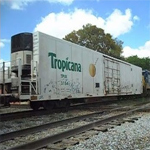Recent Blog Posts
 If you served up a tall glass of Tropicana O.J. this morning for breakfast, you're not alone millions of gallons of Tropicana's most famous juice travels from Florida up the East Coast five days a week, and the company doesn't call upon trucks to do it. Rather, trains have been the preferred mode of transportation ever since 1970, with the so-called “Juice Trains” becoming the object of huge affection, with fan clubs, photography collections and even online discussion groups created to celebrate the big orange and white cars that help deliver one of America's favorite drinks.
If you served up a tall glass of Tropicana O.J. this morning for breakfast, you're not alone millions of gallons of Tropicana's most famous juice travels from Florida up the East Coast five days a week, and the company doesn't call upon trucks to do it. Rather, trains have been the preferred mode of transportation ever since 1970, with the so-called “Juice Trains” becoming the object of huge affection, with fan clubs, photography collections and even online discussion groups created to celebrate the big orange and white cars that help deliver one of America's favorite drinks.
But before 1970, getting Tropicana juice into the hands of its thirsty customers was no easy feat. When the company was first founded in 1947, it depended on hand-delivery to nearby Floridian homes, but as demand grew—particularly in the Northeast—a ship named the S.S. Tropicana was called into service in the 1950s, taking 1.5 million gallons of juice to New York each week. (One of Tropicana's first Manhattan customers, the Waldorf-Astoria Hotel, had a standing order for 1,000 gallons of juice and fruit jars each week.)
By 1970, Tropicana realized it needed even faster and more frequent service. So in 1961, the S.S. Tropicana made its final voyage, and the concept of using a “juice train” to carry Tropicana's product was born. Originally a single, insulated boxcar that carried orange juice in bulk once a week from Florida to Kearney, N.J., the Juice Train expanded quickly. By the following year, the company was operating two 60-car unit trains a week, each carrying about one million gallons of juice. On June 7, 1971, the “Great White Juice Train” (the first unit train in the food industry, consisting of 150 100-ton insulated boxcars fabricated in the Alexandria, Va. Shops of Fruit Growers Express) commenced service over the 1,250-mile route. An additional 100 cars were soon incorporated into the fleet, and small mechanical refrigeration units were installed to keep temperatures constant on hot days. As a result of its focus on rail, Tropicana saved $40 million in fuel costs alone during the Juice Train's first 10 years in operation.
Today, the Juice Train, cooled to 34 degrees, departs five days a week, carrying juice from more than 400 Florida groves to your glass with as much speed as possible. (Incidentally, the first “Great White Juice Train” is still in operation today.) The look of Tropicana's rolling stock has also changed over the years, including orange, white, and blue cars, all designed to better advertise its famous cargo.
A reliable and economically viable transportation mode, the Juice Trains now also run 10 trips each week to Jersey City, N.J., and Cincinnati, Ohio, while additional shipments with specially equipped refrigerated cars now travel 3,000 miles by rail to California, as well.
Not surprisingly, the Tropicana-CSX Juice Trains have been the focus of countless efficiency studies and have received numerous awards, primarily because the Juice Trains are a great example of how modern rail transportation can compete successfully with trucking and other modes to carry perishable products.
- OmniRide and Virginia Railway Express Partners in Public Transit
-

-
OmniRide is honored to be able to partner with VRE to meet the travel needs of the region’s essential workers and for passengers making essential travel to employment, grocery stores, health care appointments, and more.
- VRE Mobile Update
-

-
If your phone isn't set to automatically update, open VRE Mobile and manually update by clicking "Update My App" or vist Google Play or the App Store directly.
- Commuter Connections
-

-
The coronavirus pandemic has heavily impacted the way area residents work on a daily basis. With continued travel restrictions for many, working from home has become a common practice. For those required to commute to the worksite during the pandemic, Commuter Connections never stopped providing assistance.
- Virtually Explore a Train
-

-
Wondering what the social distancing cues look like at VRE stations and on our trains? Take a peek with this interactive tour.
